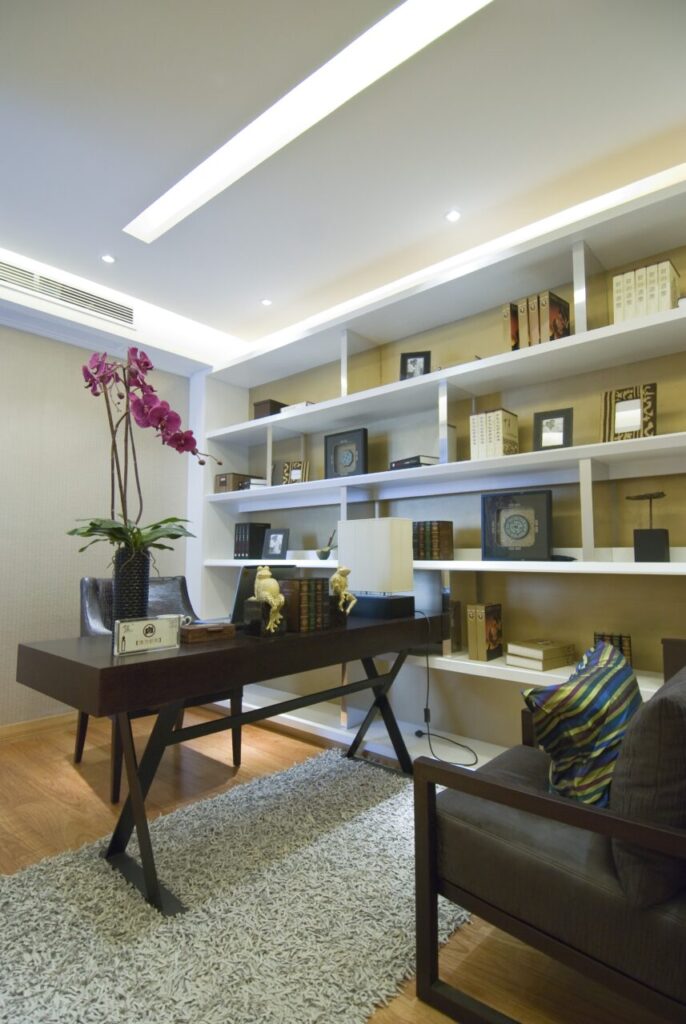Whether you work from home full time or your job has moved to a hybrid model, an optimized home office setup can go a long way toward supporting both your physical and mental health.
Do you often finish your workday feeling stiff, sore, or mentally exhausted? We spend a significant portion of our lives sitting, typing, and interacting with our environment, and often, our surroundings aren’t ideal for supporting our physical comfort and well-being.
Ergonomics is the science of fitting the workplace to the worker using a holistic approach to create environments that support our physical needs, boost productivity, and prevent injuries.
Design a Comfortable Workstation
An ergonomic workstation is one that supports your body in a neutral position and allows you to easily maintain proper posture. Consider the following:
A supportive chair.
Your chair is the foundation of your home office. Invest in an ergonomic chair that supports the natural “S” curve of your spine. Look for adjustable features like lumbar support with the ability to recline at 100 or 110 degrees, seat height, and armrests. When seated, your knees should be level with your hips or slightly below, and your feet should be able to comfortably flat on the floor. Consider adding an additional lumbar support cushion or seat pillow if your current chair lacks the right support.
An adjustable desk.
Ideally, your arms and wrists should be in a neutral position when sitting at your desk, with your arms parallel to the floor at 90 degrees, or slightly lower to reduce tension. Typical desks are between 28 and 30 inches high, which is ideal for someone 5 feet, 10 inches or taller. Since the average adult is shorter than that, most of us will benefit from a desk that features an adjustable height, allowing you to modify by half-inch increments as needed, as well as desks that alternate between sitting and standing positions during the day.
A comfortable keyboard and mouse.
Ergonomic keyboards (such as a split keyboard) and mice are designed to reduce strain on your hands and wrists, lowering the risk of conditions like carpal tunnel syndrome from repetitive movements. Your wrists should lay flat on the keyboard. Consider using a cushioned wrist pad if needed, and experiment with different devices to find what suits you best.
A well-placed monitor.
Position your monitor at arm’s length and slightly below eye level to reduce strain on your neck and upper back. Consider using an anti-glare filter to reduce eye fatigue. If using a laptop, invest in a laptop stand and external keyboard and mouse, which can significantly improve your posture and decrease discomfort.
Choose the Right Lighting
Natural sunlight plays an important role in our physical and mental well-being. It stimulates the production of essential vitamin D, as well as melatonin, the hormone responsible for regulating our sleep patterns, otherwise known as circadian rhythms. Sunlight also plays a role in reducing symptoms of anxiety, depression, and stress, but regular exposure can be a challenge in certain parts of the country, especially during the winter months.
If you can, position your desk near a window or in a naturally bright room to reap the most benefits from natural sun exposure. In addition:
⬥ Choose warm-toned LED lamps that mimic natural light, and avoid overhead fluorescents.
⬥ Use adjustable, indirect lighting to minimize screen glare.
⬥ Consider adding task lighting for specific work areas, allowing you to control the brightness of your workspace.
Create a Calm and Focused Environment
It’s hard to be productive when your surroundings are stressful. Here are some ways to cultivate an environment for better productivity and focus:
⬥ Bring the outdoors inside by incorporating plants into your home office. Not only are plants aesthetically pleasing, but they also can also lower your stress levels.
⬥ Prioritize air quality and open windows when possible to ensure good ventilation. Consider using an air purifier to minimize pollutants and allergens. Additionally, pay attention to the temperature. A room that is either too hot or too cold will detract from your ability to focus.
⬥ Customize your workspace and tailor your home office to your preferences and needs. Do you prefer calming color palettes like neutrals or earth tones? Or are you energized by vibrant colors? If you can, work with a professional to personalize the space with artwork that speaks to you, personal photos, or motivational quotes to create a positive, enjoyable atmosphere.
Add Movement and Reduce Stress
An ergonomic environment promotes a holistic well-being that goes beyond the physical setup of your home office. Here are a few tips to keep your mind-body connection in sync:
Take frequent movement breaks.
Set reminders to take short breaks throughout the day. Stand up, stretch, and move around to prevent stiffness and improve circulation. Incorporate micro-breaks for activities like deep breathing, meditation, or a quick walk around your home to recharge your mind and body.
Set boundaries with technology.
Silence notifications, designate tech-free zones, and schedule regular technology breaks to disconnect and recharge. Practice the 20/20/20 rule: for every 20 minutes of screen time, spend 20 seconds looking at something else, then at something 20 feet away. Remember, your inbox will still be there when you return, but your mental well-being is priceless.
Stay fueled and hydrated.
Proper hydration is essential for cognitive function and energy levels. Keep a water bottle within reach to sip on throughout the day. Likewise, fuel up with nutritious snacks like yogurt, fruit, or nuts to keep your energy levels steady throughout the day and avoid mind fog and burnout.
Remember that everyone’s needs are unique. Experiment with different setups until you find what works best for you. Your home office should be a haven that enhances your well-being and helps you thrive in the ever-evolving landscape of remote work.
Pocket Offices: An Increasing Trend in Home Office Design
3 Alternatives to That Ugly Office Chair Floor Mat
8 Make-or-Break Home Office Essentials You Didn’t Know You Needed


